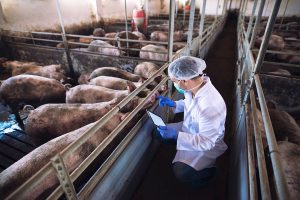THE swine industry’s water demand is lower compared to crops, and is thus less likely to be pressured during the El Niño dry spell, industry officials said.
“Unlike crops, (livestock) does not require huge amounts of water as compared to crops,” Jayson H. Cainglet, executive director of the Samahang Industriya ng Agrikultura, said in a phone interview.
Mr. Cainglet said that both commercial and backyard farmers have easier access to water compared to crops.
Rolando E. Tambago, president of the Pork Producers Federation of the Philippines, Inc., said separately that large commercial operation farms are also climate controlled to optimize growing conditions.
“They have controlled or air-conditioned buildings for piggeries. But smallholders will be affected… I cannot say by how many percent,” he said.
Mr. Tambago said the industry is still feeling the effects of African Swine Fever (ASF), which reduced supply, and the coronavirus disease 2019 (COVID-19) pandemic, which lowered demand.
The hog industry lost about 5 million head since the outbreak of ASF in 2019.
Last year, hog output rose 2.4% to 1.74 million metric tons on a liveweight basis, according to the Philippine Statistics Authority.
“Hogs are in short supply because of the large reduction in hog population so prices have risen,” he said, adding that future price increases could be muted, Mr. Tambago said.
Mr. Cainglet said there is no shortage of pork, with 60 million kilograms parked in accredited cold storage facilities, according to the National Meat Inspection Service.
“Totoong may pagbaba sa local production, but the imports from the past three years, sobra-sobra kasi hindi pa gumagalaw ang nasa cold storage (It’s true that domestic production has dropped, but imports over the past three years have been excessive and cold storage inventory has not moved),” he said.
The Bureau of Animal Industry estimates pork imports of 710,362 tons in 2022.
Mr. Tambago said demand is unpredictable “because we are now in the post pandemic era, so we cannot be certain of the strength of the economic recovery,” he said.
According to Mr. Tambago, the average farmgate price of a liveweight pig has been stable in the last two weeks, averaging P220 per kilo.
“I think it will be stable in the next maybe two to three weeks. We have not yet confirmed but there are areas in Luzon where farmgate prices went down,” he said.
Mr. Cainglet noted the “disconnect” between farmgate prices and retail prices across all commodities.”
He called for separate retail pricing for domestic and imported pork.
“The rule of thumb is farmgate price plus P90 and maximum of P100 (to get the suggested retail price). So, if the farmgate price is between P200-P220, the retail price should be P300-P310,” he said.
He said the P150 per kilo landed price of imported pork suggests a retail price of about P260.
The prevailing price of pork shoulder (kasim) as of Tuesday was between P300 and P360 while pork belly (liempo) sold for between P360 and P420, according to price monitoring reports from the Department of Agriculture. — Sheldeen Joy Talavera
